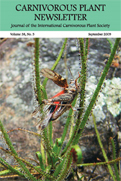International Carnivorous Plant Society
Carnivorous Plant Newsletter Archive
Ecophysiological investigation on Drosophyllum lusitanicum: Why doesn't the plant dry out?
Adamec, Lubomír
Carniv. Pl. Newslett. 38(3):71-74
Published 2009
https://doi.org/10.55360/cpn383.la180
Summary
Drosophyllum lusitanicum (L.) Link (Portuguese dewy pine; Droseraceae) is the only carnivorous plant with distinctly xerophytic features even during the growing season, in great contrast to the general strategy in other carnivorous plants. It grows sporadically in a limited area in the subtropical Southern and Western parts of the Iberian Peninsula in Spain and Portugal as well as at the northernmost tip of Africa in Morocco.
Keywords: Drosophyllum lusitanicum
Article Citation
Adamec, Lubomír. 2009. Ecophysiological investigation on Drosophyllum lusitanicum: Why doesn't the plant dry out?. Carniv. Pl. Newslett. 38(3):71-74. https://doi.org/10.55360/cpn383.la180
Page views: 944
©2025 International Carnivorous Plant Society
www.carnivorousplants.org
This page is maintained by John Brittnacher.
Please contact us at our membership website, icps.clubexpress.com.
Privacy: The Carnivorous Plant Newsletter Archive website does not track users.

